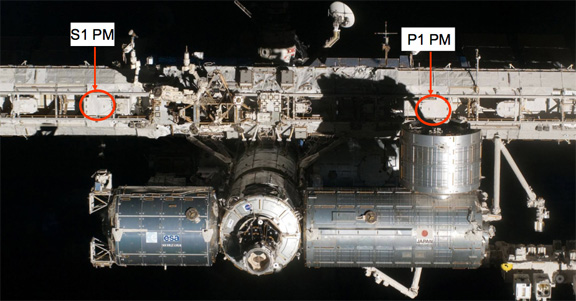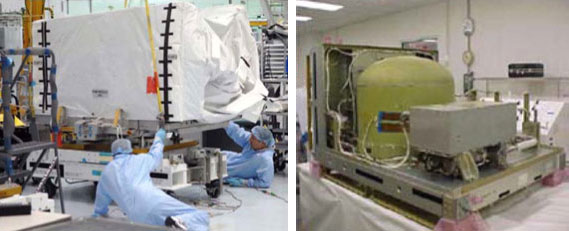Engineers troubleshoot station cooling problem
12/11/2013 07:50 PM Filed in: Space News | International Space Station
Editor's note...
CBS News
A valve in a coolant system pump module aboard the International Space Station apparently malfunctioned Wednesday, triggering cooling problems in one external ammonia loop and prompting flight controllers to power down non-essential equipment in the forward part of the lab complex, including some of the station's research gear.
The lab's six-member crew was not in any danger, NASA officials said, following a near-normal schedule while engineers on the ground "collect more data and consider what troubleshooting activities may be necessary.
In the meantime, the heat generated by the station's myriad electrical systems is being dissipated by ammonia circulating in coolant Loop B. Coolant Loop A, hobbled by the suspect flow control valve, remained in operation Wednesday evening, but it could not be used for heat rejection.
Some equipment in the forward Harmony module, known as Node 2, and two lab modules that are attached to it -- the European Space Agency's Columbus laboratory and Japan's Kibo module -- could not be fully cooled by loop B alone and some of those systems had to be powered down.
"The ETCS (External Thermal Control System) Loop A is still running, but the flow control valve doesn't appear to be positioning properly," a flight controller radioed the crew earlier Wednesday. "So the Loop A is very cold. We're not expecting it to get warm enough for us to be able to reintegrate for heat rejection."
She said Loop A would be kept in operation as long as possible to carry out "graceful shutdowns of our science equipment. Once the loop shutdown is complete, half of Node 2, half of JEM (Japanese Experiment Module) and half of Columbus will be powered down. But you'll keep half of each module and that is why the crew quarters are not affected."
"Meanwhile, all the thermal loops have been shifted to Loop B, which is struggling to keep up. So we're going to be looking at some additional power downs in other modules to make sure that the highest priority loads get adequate cooling."
It is not yet clear if the apparent problem with the flow control valve is the result of a hardware issue or the software that controls it. If it is software related, a NASA official said, engineers likely will come up with a work-around. If the hardware is at fault, a spacewalk could be required at some point to install a replacement.
The pump module in question was installed during three spacewalks in 2010 after an earlier failure that disabled that loop completely.
In the meantime, NASA and Orbital Sciences Corp. are pressing ahead with plans to launch an unmanned Cygnus cargo ship Dec. 18, Orbital's first operational station resupply mission. Berthing at Harmony's Earth-facing port is expected Dec. 21, assuming no major disruptions because of the coolant system issue.
he space station uses ammonia circulating through a complex system of heat exchangers, plumbing and radiators to dissipate the heat generated by the lab's myriad electrical systems. Flight controllers can use excess capacity in one loop to cool components in the other, but not all systems can remain powered with a single operational coolant loop.
Given the lost redundancy, flight controllers and engineers want to come up with repair options as quickly as possible. Among the systems affected by the powerdown were specific smoke detectors in the forward modules, along with some caution and warning displays, but backup systems remained available.
"Earlier today, the pump module on one of the space station’s two external cooling loops automatically shut down when it reached pre-set temperature limits," NASA said in a statement. "These loops circulate ammonia outside the station to keep both internal and external equipment cool.
"The flight control teams worked to get the cooling loop back up and running, and they suspect a flow control valve actually inside the pump itself might not be functioning correctly. At no time was the crew or the station itself in any danger, but the ground teams did work to move certain electrical systems over to the second loop.
"Some non-critical systems have been powered down inside the Harmony node, the Kibo laboratory and the Columbus laboratory while the teams work to figure out what caused the valve to not function correctly and how to fix it. The crew is safe and preparing to begin a normal sleep shift while experts on the ground collect more data and consider what troubleshooting activities may be necessary."
- Posted at 05:50 PM EST, 12/11/13: Engineers troubleshoot station cooling glitch
- Updated at 07:10 PM EST, 12/11/13: Adding air-to-ground conversation about coolant problem; NASA statement
- Updated at 07:50 PM EST, 12/11/13: Clarifying status of coolant loop
CBS News
A valve in a coolant system pump module aboard the International Space Station apparently malfunctioned Wednesday, triggering cooling problems in one external ammonia loop and prompting flight controllers to power down non-essential equipment in the forward part of the lab complex, including some of the station's research gear.
The lab's six-member crew was not in any danger, NASA officials said, following a near-normal schedule while engineers on the ground "collect more data and consider what troubleshooting activities may be necessary.
In the meantime, the heat generated by the station's myriad electrical systems is being dissipated by ammonia circulating in coolant Loop B. Coolant Loop A, hobbled by the suspect flow control valve, remained in operation Wednesday evening, but it could not be used for heat rejection.
 |
| Viewed from just ahead of the International Space Station, the faulty loop A pump module -- PM1 -- is located in the starboard one, or S1, truss segment. (Credit: NASA) |
Some equipment in the forward Harmony module, known as Node 2, and two lab modules that are attached to it -- the European Space Agency's Columbus laboratory and Japan's Kibo module -- could not be fully cooled by loop B alone and some of those systems had to be powered down.
"The ETCS (External Thermal Control System) Loop A is still running, but the flow control valve doesn't appear to be positioning properly," a flight controller radioed the crew earlier Wednesday. "So the Loop A is very cold. We're not expecting it to get warm enough for us to be able to reintegrate for heat rejection."
She said Loop A would be kept in operation as long as possible to carry out "graceful shutdowns of our science equipment. Once the loop shutdown is complete, half of Node 2, half of JEM (Japanese Experiment Module) and half of Columbus will be powered down. But you'll keep half of each module and that is why the crew quarters are not affected."
"Meanwhile, all the thermal loops have been shifted to Loop B, which is struggling to keep up. So we're going to be looking at some additional power downs in other modules to make sure that the highest priority loads get adequate cooling."
It is not yet clear if the apparent problem with the flow control valve is the result of a hardware issue or the software that controls it. If it is software related, a NASA official said, engineers likely will come up with a work-around. If the hardware is at fault, a spacewalk could be required at some point to install a replacement.
The pump module in question was installed during three spacewalks in 2010 after an earlier failure that disabled that loop completely.
In the meantime, NASA and Orbital Sciences Corp. are pressing ahead with plans to launch an unmanned Cygnus cargo ship Dec. 18, Orbital's first operational station resupply mission. Berthing at Harmony's Earth-facing port is expected Dec. 21, assuming no major disruptions because of the coolant system issue.
 |
| An ammonia coolant pump module, with insulation removed (right) and in place (left). (Credit: NASA) |
he space station uses ammonia circulating through a complex system of heat exchangers, plumbing and radiators to dissipate the heat generated by the lab's myriad electrical systems. Flight controllers can use excess capacity in one loop to cool components in the other, but not all systems can remain powered with a single operational coolant loop.
Given the lost redundancy, flight controllers and engineers want to come up with repair options as quickly as possible. Among the systems affected by the powerdown were specific smoke detectors in the forward modules, along with some caution and warning displays, but backup systems remained available.
"Earlier today, the pump module on one of the space station’s two external cooling loops automatically shut down when it reached pre-set temperature limits," NASA said in a statement. "These loops circulate ammonia outside the station to keep both internal and external equipment cool.
"The flight control teams worked to get the cooling loop back up and running, and they suspect a flow control valve actually inside the pump itself might not be functioning correctly. At no time was the crew or the station itself in any danger, but the ground teams did work to move certain electrical systems over to the second loop.
"Some non-critical systems have been powered down inside the Harmony node, the Kibo laboratory and the Columbus laboratory while the teams work to figure out what caused the valve to not function correctly and how to fix it. The crew is safe and preparing to begin a normal sleep shift while experts on the ground collect more data and consider what troubleshooting activities may be necessary."